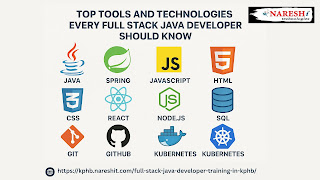Must-Know Tools and Technologies for Every Full Stack Java Developer in 2025
If you're planning to become a Full Stack Java Developer, congratulations — you're aiming for one of the most in-demand and rewarding careers in the software world. But it’s not just about learning Java. Today’s full stack roles demand a broad skill set covering frontend, backend, database, DevOps, and more.
Whether you’re a student, fresher, or working professional considering Full Stack Java Training in KPHB, this guide will walk you through the key tools and technologies you’ll need to master.
🔧 Backend: Core Java & Spring Ecosystem
Your full stack journey starts with mastering Core Java — this includes object-oriented programming, exception handling, collections, and multithreading. But to build powerful web apps, you'll also need to dive into:
-
Spring Boot – Quickly build RESTful APIs and microservices.
-
Spring MVC – For creating structured web apps.
-
Spring Security – Add login, roles, and protection.
-
Spring Data JPA – For seamless database interaction.
These tools help you build scalable and secure applications with ease.
🎨 Frontend: Building User Interfaces
Once the backend is ready, it’s time to work on what users actually see. You’ll need to get hands-on with:
-
HTML5, CSS3 & JavaScript – The foundation of any frontend.
-
Bootstrap – For mobile-first, responsive designs.
-
React.js or Angular – For building modern, dynamic single-page applications (SPAs).
-
TypeScript – Especially useful if you choose Angular.
Frontend skills make you more than just a backend developer — they make you complete.
🗃️ Databases: Managing Application Data
No application is complete without proper data management. You should be comfortable with:
-
MySQL or PostgreSQL – For structured, relational data.
-
MongoDB – For flexible, document-based storage.
-
Hibernate ORM – Java’s most popular ORM tool.
Database skills ensure your app stores and retrieves information efficiently.
🛠️ DevOps & Deployment: Real-World Project Experience
As a full stack Java developer, you’ll likely be expected to know the basics of DevOps and deployment. That includes:
-
Git & GitHub – For version control and code sharing.
-
Docker – Create lightweight containers for your app.
-
Jenkins – Automate your build, test, and deploy pipeline.
-
Maven or Gradle – Handle your Java project dependencies.
You don’t need to be a DevOps expert — just knowing how to work with these tools is enough to stand out.
🔗 API Development & Testing
Modern applications talk to each other via APIs. So, learning to build, consume, and test APIs is a must.
-
REST APIs – The backbone of communication between frontend and backend.
-
Postman – Helps you test and debug your APIs.
-
Swagger – For documenting APIs for teams and clients.
🧪 Testing Frameworks: Write Bug-Free Code
Testing is not optional in professional environments. You should learn:
-
JUnit – For unit testing your Java code.
-
Mockito – For mocking external dependencies.
-
Selenium – For automating frontend testing.
This ensures your code works well before it reaches users.
💼 Project & Team Collaboration Tools
Every full stack developer is also part of a team. Familiarity with project tools helps you stay productive and organized:
-
JIRA / Trello – For managing sprints and tasks.
-
Slack / MS Teams – For daily team communication.
Final Words: Start Your Full Stack Java Journey the Right Way
Being a full stack Java developer is like being a tech superhero — you can build, test, and deploy entire applications on your own.
If you’re based in Hyderabad or nearby, consider enrolling in Full Stack Java Training in KPHB. It’s a great place to learn from experienced mentors, build real-world projects, and get career-ready.
👉 Want to know more?
-
Check out our FAQs
-
Visit our website to enroll today!
.jpg)
.jpg)

Comments
Post a Comment